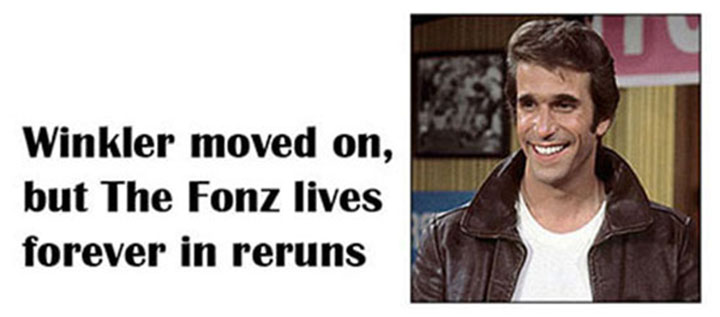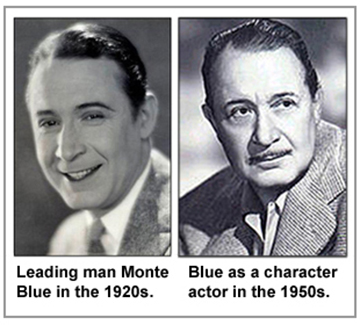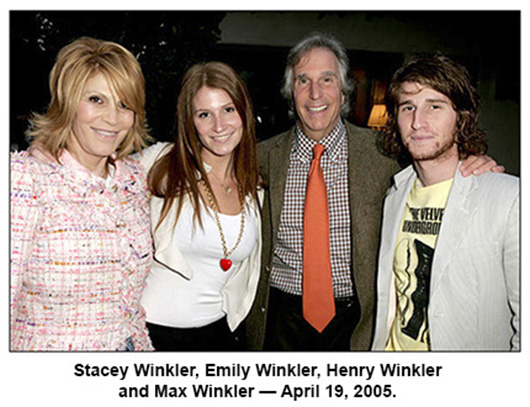| HOME • FAMILY • YESTERDAY • SOLVAY • STARSTRUCK • MIXED BAG |
 |
 |
I don't know what prompted the question, but back in the 1950s, when I was in my teens, I asked my mother if she had had a favorite movie star when she was my age. The answer I expected, I guess, was Rudolph Valentino, Ramon Navarro, Douglas Fairbanks Sr. or one of the other legends of the silent era. John Gilbert, perhaps. She thought a moment, then said a name I had never heard before: Monte Blue. Almost immediately she wanted to retract her answer and plead the fifth. My mother was very self-conscious and afraid, I guess, that I'd revert to childhood and start running around the house, yelling, "Mommy loves Monte Blue! Mommy loves Monte Blue!", which would encourage my younger sister to join in. My mother had no old photograph of Blue to show me. So I had no idea what he looked like. His silent movies weren't being shown on television. In those days there was no such thing as cable or Turner Classic Movies. Worse for my mother, she knew Monte Blue was still acting, looking nothing at all like a leading man. He had been born Gerald Montgomery Bluefeather. His father was half French, half Cherokee Indian. Late in life Blue often was cast as an Indian. He played Geronimo in the 1954 film, "Apache," when he was 71. He may be best remembered now as Sheriff Ben Wade in the 1948 Humphrey Bogart-Lauren Bacall movie, "Key Largo." So when I spotted Blue one evening and pointed to him on our television screen, my mother was embarrassed. The movie star favorite of her youth had turned into an overweight old man. Today, of course, I can see Blue in his prime. This change, made possible by technological advances and America's insatiable appetite for entertainment and a zillion cable stations and streaming options, benefits today's parents when it comes time to answer questions from their children. Such as "Who or what is The Fonz? And what's the big deal?" If you had to introduce them to Henry Winkler through one of his appearances on "Royal Pains," where he played the father of the two main characters, then your kids would look at you like I looked at my mother the first time I saw Monte Blue. However, parents today don't have to do that because they can go directly to the source – a rerun of "Happy Days," which can be viewed at home in a number of ways. "There's The Fonz! Isn't he cool?" One other big cultural change is that movies and television programs don't age as quickly as they used to. Even music holds up much better than it did when I was a kid. In the 1950s there wouldn't have been any market for DVDs of 1920s movies or songs. Today there's a market for everything. And except for one very dreary period when both fashion and movie music went hideously astray – I think it was called the 1970s – the old stuff remains entertaining. All this leads up to a phone interview I had with Henry Winkler when he was riding high as The Fonz. Obviously, Winkler and The Fonz were not much alike, thanks to something called acting, but in some way the two did think alike. My favorite Winkler/Fonz moment came in the very first episode of "Happy Days" when The Fonz was in the men's room, standing in front of a mirror, wondering if any pruning was necessary. He whipped out a comb from his back pocket, checked the mirror again, then shrugged and replaced the comb. You can't improve on perfection. The idea was Winkler's, but the reaction was pure Fonzie. Winkler has proven to be a cool guy ever since. He even had the good sense to avoid the motorcycles his TV counterpart loved so much. |
|
|
|
Two years after our interview, Henry Winkler got married — to Stacey Weitzman. For the past several years he has been one of the country's busiest actors making multiple appearances in such series as "Parks and Recreation," "Children's Hospital," "Royal Pains," "Hank Zipzer," "Arrested Development," and "Barry," for which he won an Emmy award as best supporting actor in a comedy series. This page was last checked this year (2023), and Winkler, at 77, is still very active. |
|
|
|
| HOME • STARSTRUCK • CONTACT |
 A tall (6-foot-3), rugged man, Blue played football at Purdue, then did a variety of physical jobs before he become an actor rather late, which made him several years older than many of the actors of the silent era. When my mother became a Monte Blue fan – she'd never put it that way, of course – the handyman-turned-actor was nearly 40.
A tall (6-foot-3), rugged man, Blue played football at Purdue, then did a variety of physical jobs before he become an actor rather late, which made him several years older than many of the actors of the silent era. When my mother became a Monte Blue fan – she'd never put it that way, of course – the handyman-turned-actor was nearly 40.